This article was co-authored by Ashley Mak, DPT. Ashley Mak is a Physical Therapist and the Owner of Ashley Mak Performance and Rehabilitation, his physical therapy business based in Hoboken, New Jersey. He is also the CEO of Hudson River Fitness and an Adjunct Professor at Kean University. With over seven years of physical therapy experience, Ashley specializes in both pain management and maximizing physical performance. He received his BA in Biology from Villanova University in 2010 and his Doctorate in Physical Therapy (DPT) from Thomas Jefferson University in 2012.
There are 22 references cited in this article, which can be found at the bottom of the page.
This article has been viewed 101,981 times.
Posture is the way in which you hold yourself while sitting, standing, and lying down. Good posture keeps all of your joints and bones aligned, reducing stress on muscles and ligaments.[1] Maintaining good posture is important to prevent muscle fatigue and injury. Poor posture often leads to back pain, but there are several small changes you can make to your daily routine to prevent this by improving your posture. Seek expert advice before and after these changes to prevent injury.
Steps
Maintaining Good Posture While Sitting and Lying Down
-
1Set up your computer monitor at eye level. Position the computer screen directly in front of the user so the body and neck do not have to twist to view.[2] Ensure the screen rests at eye level so you do not have to tilt your head up or down to see the screen properly.
- Keep your head level while using the computer to keep your spine straight.
- Avoid tucking your chin into your chest.
-
2Use an ergonomic chair with proper lumbar support. If you have a desk job that requires you to sit for many hours a day, a chair with proper back support is a must. The lower back has an inward curve that straight-backed chairs do not account for. Sitting for extended amounts of time in a straight-backed chair can lead to back pain and muscle fatigue.[3]
- Purchase a chair with a curved back or one that has an adjustable lumbar support.
- You can make a DIY lumbar support by using a rolled up towel or pillow and placing at the base of your spine.
- Lumbar support add-ons can also be purchased for a marginal price if you don't want to buy a whole new chair.
Advertisement -
3
-
4Sit with both feet on the ground and your knees at or above hip level. When sitting for a long time, you might be tempted to cross your legs or slouch. The best way to keep good posture at your desk is to keep both feet planted on the ground.[6] Use a footrest, if necessary.
- Keep your back straight against the chair.
- Keep your shoulders relaxed, but not rounded down or pulled backward.
-
5Stretch, walk, or stand every half hour.[7] It's easy to get bogged down in work, but your posture will thank you by frequently moving a little bit. Set a timer on your desk and when it goes off stand up and stretch out. Walk to the break room to get some water, or go say hi to a workmate.[8]
- You don't have to go on an extended walk, just take a lap around the office.
-
6Drive sitting with your back firmly against the seat for proper support. Avoid reclining the seat too far. Use a lumbar support at the curve of your back. Make sure your knees are at the same level or higher than your hips.[9]
- Move the seat close enough to the steering wheel to allow your knees to bend properly and your feet to reach the pedals.
-
7Sleep on a firm mattress with pillows. Find a mattress that is comfortable for you, but know that firm mattresses are recommended.[10] Avoid sleeping on your stomach or curled up into a ball.[11] If you are sleeping on your side, place a pillow between your legs to support spinal alignment during sleep. If you sleep on your back, place a pillow underneath your knees.[12]
- Sleep with a pillow under your head as well. Choose a pillow that allows you to keep your head in a neutral position so that your head is neither in a flexed or extended position while sleeping.
- Do not sleep with a pillow under your shoulders.
Maintaining Good Posture While Standing
-
1Know the correct way to stand. Having good posture while standing is important, especially if you are on your feet all day. If you are standing with proper posture, you reduce stress on your body and may actually have more energy, as your muscles are used most efficiently when you have good posture.[13] Use the following guidelines to make sure you are standing correctly.[14] [15]
- Hold your head up straight, not tilted forward, backward, or to the side. Picture a string attached to the top of your head, and someone is gently pulling it, keeping your head lifted.
- Keep your shoulder blades back, but not so far that they are touching.
- Knees should be straight, but not locked.
- Tuck your stomach in without tilting your pelvis forward of backwards.
- Keep your weight on the balls of your feet.
-
2Bend from the knees when lifting heavy objects.[16] Avoid lifting objects heavier than 30 pounds, but when necessary, always bend at the knees first. Keep your back straight and bend your knees and hips to retrieve the object. Never bend forward from the waist with straight knees.
- Use a wide stance with feet firmly planted on the ground. Start close to the object.
- Straighten your knees in a steady motion, standing upright without twisting the body.
- Hold heavy objects close to you, with elbows bent and stomach muscles tight.
-
3Wear supportive shoes. If you are on your feet all day, you'll want to look for shoes designed for comfort and to adequately support the weight of your body. Look for brands that offer added support and cushioning, plus a roomy toe.[17]
- Look into orthotic shoes or inserts to support good posture, and avoid high heels.[18]
-
4Test your standing posture. You can easily check your posture by doing a wall test. Stand against a wall, with your head, shoulder blades, and buttocks touching the wall. Your heels should be two to four inches from the wall. Place your palm against the wall and slide your hand behind your lower back.[19]
- If your posture is good, then there should be a space about the width of a hand between your back and hand.
- If there is more space than that, then you can flatten the curve of your back by tensing your abdomen and pulling in your belly button.
- If there is less space and your back is touching your hand, arch your back until it is no longer touching your hand.
- Once you have corrected your posture, walk away from the wall. Remember how you had to adjust your body to achieve good posture, and make an effort to correct your posture throughout the day.
-
5Consider a device to help you maintain good posture. You could buy a back support brace, which can be worn under your clothes. You can buy different types of braces to support different parts of your back, such as a belt for lumbar support or a brace that focuses on pulling your shoulders back.
- In addition, you might investigate devices that are on the cutting edge of technology, such as a sensor that attaches to your shirt and buzzes when you slouch or one that sticks to your lower back. You can even download an app that detects when you're craning your neck over your smartphone.
Adding Exercises to Your Daily Routine
-
1Develop a stretching routine. If you are just starting out, keep your routine short and simple. Try to make it a daily or every other day habit.[20] There are a number of small stretches that can be performed to quickly increase good posture. Try adding some of these exercises to your daily routine:[21]
- Shoulder rolls: Stand or sit comfortably. As you inhale, lift your shoulders up towards your ears. On the exhale, roll them back, squeezing your shoulder blades together. Repeat five to 10 times.
- Release chest: Raise your arms just below your shoulders, keeping palms facing forward. As you inhale, raise your straight arms in front of you, just below the shoulders, keeping palms facing forward. As you exhale, slowly rotate palms so that your fingers point behind you while you open up your arms, similar to a hugging movement. Repeat three to five times.
- Pyramid: Step your right foot back so it is flat against the floor and square your hips. With both legs straight, clasp arms behind your back and lean forward from your hips. Keep your back straight and do not round your spine. Take three to five breaths from this position and rise back to standing. Repeat on the other side.
- Snow angels: Lie down on the floor and slowly make snow angels with your arms for two to three minutes. Put a rolled up towel underneath your middle spine to increase the stretch.[22] Do not put the towel under your lower back, as this can cause you to hyperextend your back.
-
2Strengthen your core with a Pilates or yoga course. Keeping your core muscles tight helps maintain good posture. Pilates and yoga classes focus on strengthening pelvic and abdominal muscles. Strengthening your core helps support your muscles and keep everything balanced.
- Check your local gym or fitness studio for available classes.
- Start at the beginner level to avoid injury.
- Some simple exercises you can try at home include:[23]
- Bridge: Lie on your back with your knees bent. Keep your hips straight and tighten your abdominal muscles. Raise your hips until they are aligned with your knees and shoulders, forming a 90 degree angle. Hold for three breaths and slowly lower your hips back to the ground. Repeat three to five times.
- Side plank: Lie on your left side, raising your body onto your left forearm. Align your left shoulder over your left elbow, keeping knees, hips, and shoulders aligned. Rest your right arm against the side of your body. Lift your hips off the ground engaging your abdominal muscles. Hold for three breaths. Repeat three to five times and then switch to the right side. To increase the difficulty, straighten your arm and support your weight on your hand instead of resting on your forearm.
- Superman: Lie flat on your stomach with your arms in front of you and your legs straight out behind you. Lift your arms and legs as high as you can, keeping all of your joints aligned straight. Hold for three breaths. Repeat three to five times. You can place a pillow under your stomach to reduce the likelihood of hyperextending your back.
- Russian twist:[24] Sit on the floor with your knees bent. Lean back just enough to make a V-shape between your thighs and upper body. Keep a natural curve in the lower back. Extend your arms fully out in front of you and twist your torso to the left side until your arms touch the floor. Return to a neutral position, pause, and then twist to the right. Twist back to the right side. Do this from anywhere between 20 – 50 times. To make it more difficult, hold a weight in your hands.
-
3Strengthen your spine muscles. Oftentimes, bad posture is the product of weakened or imbalanced muscles.[25] To correct this, try doing exercises that specifically focus on strengthening the muscles around the spine, such as the back extensors, neck flexors, and side muscles. Ask a trainer at the gym to suggest some strengthening exercises using the equipment available or try some of the simple exercises below.
- Reverse fly: Stand up straight, with knees slightly bent, back straight, and feet shoulder-width apart. Holding a 5-8 pound weight in each hand, bend forward at the hips, keeping your back straight. With palms facing down, raise your arms up as far as you can, squeezing your shoulder blades together. It should look like you are "spreading your wings." Keep your elbows slightly bent and make sure your head remains in a neutral position and is not flexed forward. Do two sets of 15 reps.
- Row: Hold a five to eight pound weight in each hand. Stand with feet shoulder-width apart, knees bent, and lean forward at the hips keeping your back straight. Pull your hands up toward your chest and squeeze your shoulder blades together. Do two sets of 10 reps.
- Arm and leg extension: Start on all fours keeping your back straight. Raise your left leg and extend it back behind you. With the leg extended, lift your right arm and reach forward. Hold this for five seconds and then switch sides. Repeat 10 times.
- If any of these exercises cause extreme pain, stop immediately and talk to your doctor.
Maintaining Bone Health
-
1Walk briskly for a few hours a week. Cells in your bones respond to stress by increasing bone density.[26] Brisk walking is one way to lightly increase stress and encourage new bone growth.
- Walking for just 30 minutes a day can increase bone density.
- Consult a specialist before adding any intensive workouts to your daily routine.
-
2Take vitamin D for bone and muscle health. Keeping your muscles and bones strong will help prevent a hunched back as you age. It will also help you maintain good posture while you're young. Vitamin D is essential for strong bones.[27] Your body makes vitamin D in response to the sun, but be sure to wear sunblock. You can also increase vitamin D intake with a multivitamin or supplement.[28]
-
3Take medications for bone loss. There are medications available to slow bone loss and increase bone density.[29] These are usually used after a diagnosis of osteoporosis (bone loss) has been confirmed. Consult a doctor if you think this might be a good option for you.
-
4Eat calcium and nutrient-rich foods. Green leafy vegetables are a great source of calcium and other essential nutrients needed for a healthy diet.[30] Milk and calcium-enriched juices are also a good source to increase calcium. Calcium citrate or calcium carbonate supplements may also be used.
- If you take a supplement, avoid taking it with other calcium rich foods. If you have milk for breakfast, take your pill at lunch.
References
- ↑ https://www.acatoday.org/Patients/Health-Wellness-Information/Posture
- ↑ http://www.spineuniverse.com/wellness/ergonomics/workstation-ergonomic-tips-computer-monitors-posture
- ↑ Ashley Mak, DPT. Physical Therapist. Expert Interview. 3 March 2020.
- ↑ http://www.ncbi.nlm.nih.gov/pmc/articles/PMC2793460/
- ↑ http://www.ncbi.nlm.nih.gov/pubmed/16410033
- ↑ http://www.mayoclinic.org/healthy-lifestyle/adult-health/multimedia/back-pain/sls-20076817?s=5
- ↑ https://www.ccohs.ca/oshanswers/ergonomics/office/stretching.html
- ↑ Ashley Mak, DPT. Physical Therapist. Expert Interview. 3 March 2020.
- ↑ https://my.clevelandclinic.org/health/diseases_conditions/hic_Posture_for_a_Healthy_Back
- ↑ https://www.acatoday.org/Patients/Health-Wellness-Information/Posture
- ↑ https://my.clevelandclinic.org/health/diseases_conditions/hic_Posture_for_a_Healthy_Back
- ↑ https://www.acatoday.org/Patients/Health-Wellness-Information/Posture
- ↑ http://www.mayfieldclinic.com/PE-POSTURE.htm
- ↑ http://www.mayfieldclinic.com/PE-POSTURE.htm
- ↑ http://www.acatoday.org/Patients/Health-Wellness-Information/Posture
- ↑ https://my.clevelandclinic.org/health/diseases_conditions/hic_Posture_for_a_Healthy_Back
- ↑ http://www.neamb.com/insurance/take-the-ache-out-of-standing-all-day.htm
- ↑ http://www.neamb.com/insurance/take-the-ache-out-of-standing-all-day.htm
- ↑ http://www.mayoclinic.org/healthy-lifestyle/adult-health/multimedia/back-pain/sls-20076817?s=4
- ↑ Ashley Mak, DPT. Physical Therapist. Expert Interview. 3 March 2020.
- ↑ https://www.realsimple.com/health/fitness-exercise/shoulder-rolls
- ↑ http://www.health.com/health/gallery/0,,20446224_3,00.html
- ↑ http://www.mayoclinic.org/healthy-lifestyle/fitness/multimedia/core-strength/sls-20076575?s=3
- ↑ http://www.bodybuilding.com/fun/beginner-core-training-guide.htm
- ↑ http://www.bodybuilding.com/fun/posture-power-how-to-correct-your-body-alignment.html
- ↑ https://www.health.harvard.edu/exercise-and-fitness/walking-for-health
- ↑ http://www.health.com/health/gallery/0,,20446224_9,00.html
- ↑ https://www.nhs.uk/conditions/vitamins-and-minerals/vitamin-d/
- ↑ https://www.health.harvard.edu/womens-health/osteoporosis-drugs-which-one-is-right-for-you
- ↑ https://www.bonehealthandosteoporosis.org/patients/treatment/nutrition/
About This Article
To maintain good posture while sitting down, set up your computer monitor so that the screen is at eye-level and try to avoid tucking your chin while you're working. Also, use an ergonomic chair with proper lumbar support, especially if your job requires you to sit for long stretches of time, and be sure to keep your back flat against the chair. Avoid crossing your legs when you're sitting and keep both feet flat on the ground with your knees at or above hip level to maintain good posture. For tips on maintaining good posture while standing or lying down, read on!

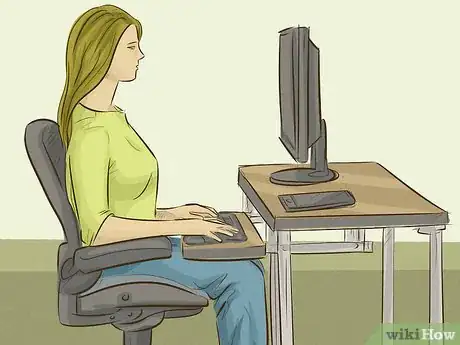

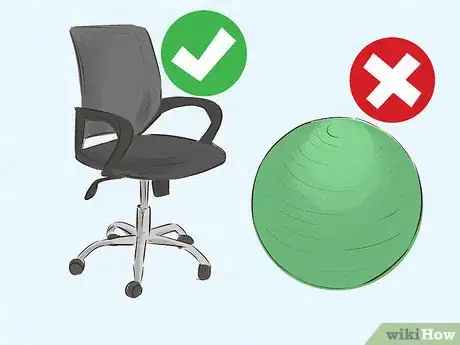
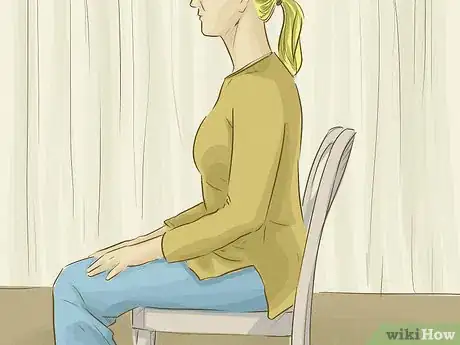

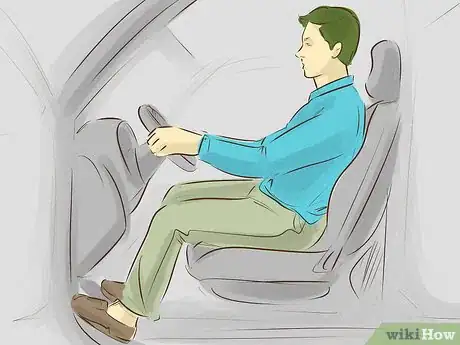
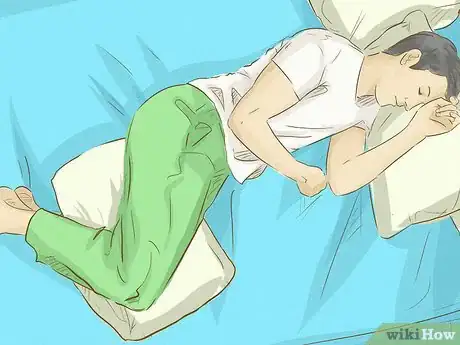

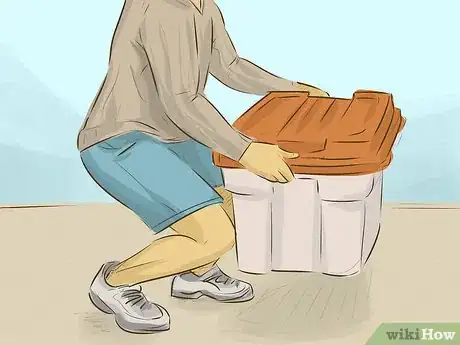
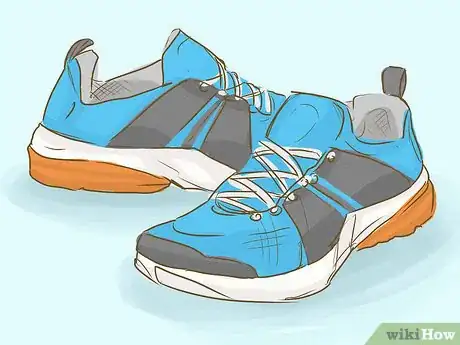
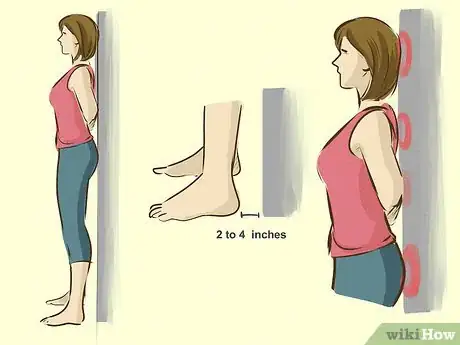


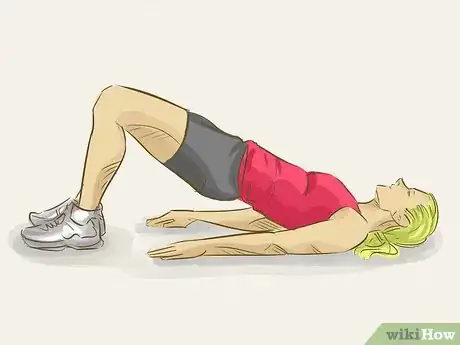
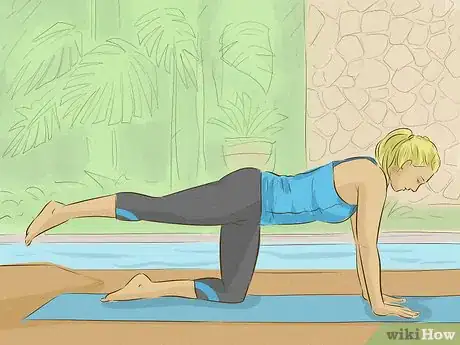
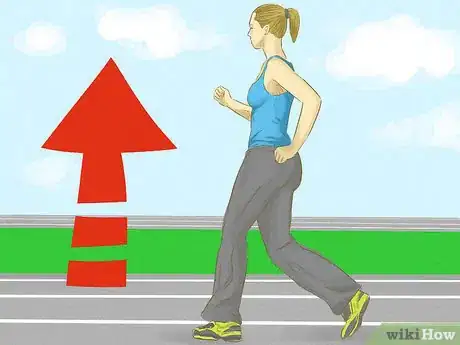



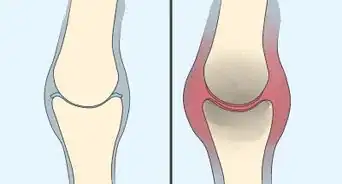
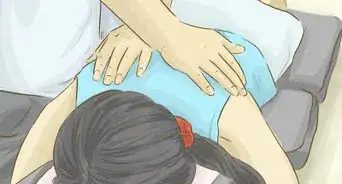
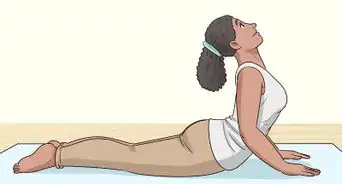







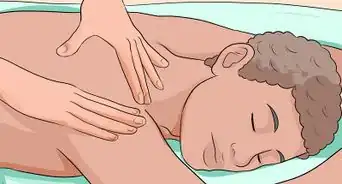
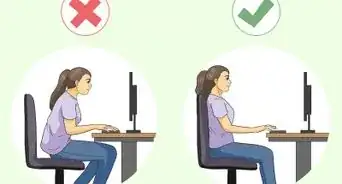








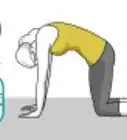

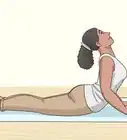




































Medical Disclaimer
The content of this article is not intended to be a substitute for professional medical advice, examination, diagnosis, or treatment. You should always contact your doctor or other qualified healthcare professional before starting, changing, or stopping any kind of health treatment.
Read More...